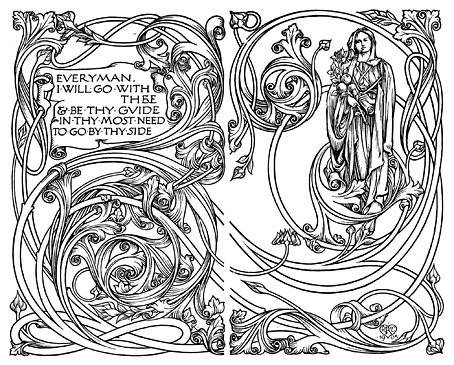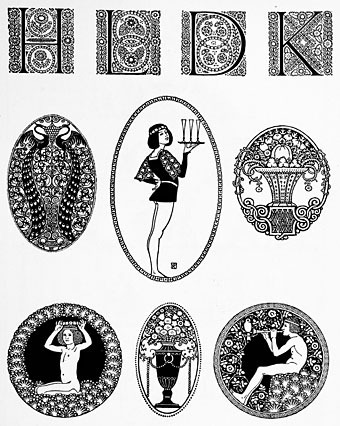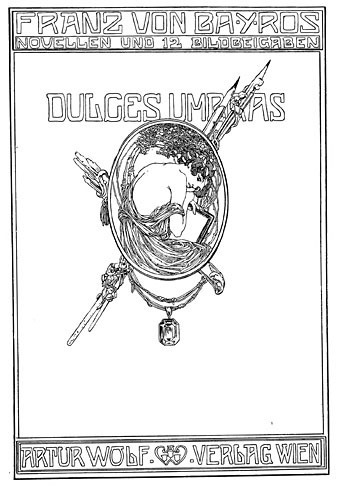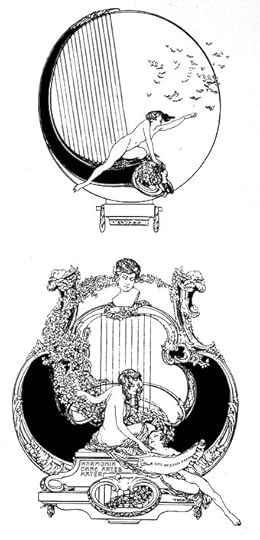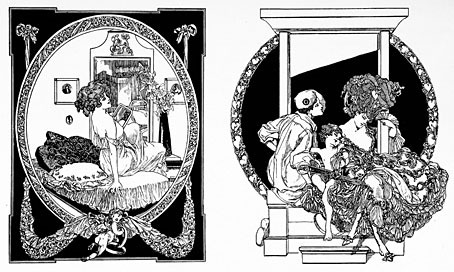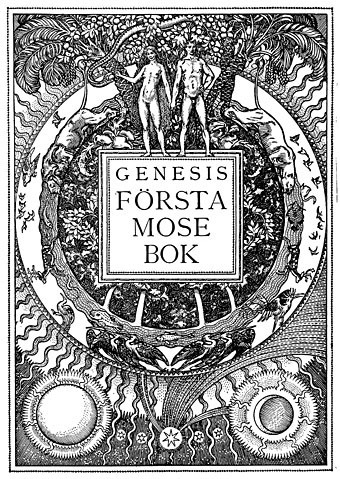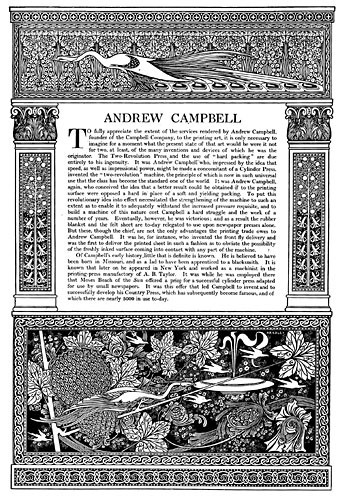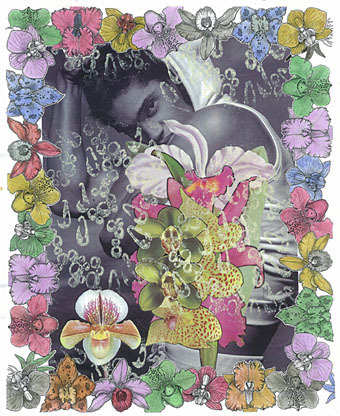John Coulthart's Blog, page 311
May 5, 2011
The mirror of Narcissus

Browsing another fin de siècle magazine—Revue des Arts Décoratifs for 1897—turned up this design for a hand-mirror by Henri Nocq (or Henry as they also name him). Illustrational design was a common feature of the Art Nouveau period, and Nocq's Narcissus-themed mirror is an ingenious confection complete with etched pond ripples, pearl-flowered lily pads, and even (though you can barely see it here) a carnelian frog. The body of the mirror was silver with narcissus flowers moulded into the obverse side. I'm surprised I haven't come across this object before which makes me think it may not have survived. (Unless you know better…) As for Henri Nocq, there's far more attention devoted to the portrait of him by Toulouse-Lautrec (also 1897) than there is to the designer.


For a more contemporary sculptural take on the theme, there's Narcissus, an early work from 1969 by British artist William Pye. See his website for other work including some gorgeous water sculptures.
Previously on { feuilleton }
• Le Baiser de Narcisse
• Reflections of Narcissus
• Narcissus
May 4, 2011
Anita Berber
Anita Berber (1925) by Otto Dix.
If you're going to live fast and die young you can do worse than be immortalised by a great painter, as Anita Berber was by the German Expressionist Otto Dix. An "exotic dancer" (among other things) in the Berlin cabarets of the 1920s, Ms Berber died at the age of 29 from a bout of TB but it's likely that drink and drugs (she was fond of both) would have ruined her eventually. She left us with this striking picture, many equally striking photos, and tales of scandalous behaviour involving nude dancing and sexual partners of any gender. Rather than paraphrase further, I can point you to a typically fine piece about Ms Berber at Strange Flowers. Ten Dreams has more paintings by the great Otto whose Berber portrait was used on a German postage stamp in 1991. Impossible to imagine the Royal Mail putting a bisexual drug addict on a postage stamp here, no matter how celebrated the artist.
May 3, 2011
The Art of the Book
Endpaper design by Reginald L Knowles for JM Dent's Everyman's Library series.
A few of the many illustration samples to be found in The Art of the Book, an overview of book design published in 1914. The editor was Charles Holme, also the editor of leading art magazine The Studio from whose contents and resources books such as this were easily compiled. The Internet Archive has a nice collection of Holme's books, and this particular volume includes work from Hungary and Sweden, two countries which are often overlooked in creative surveys. I've selected illustrations here but the book contains many examples of binding design and page layouts.
Initial letters and ornaments by Friedrich Wilhelm Kleukens.
Several pages are devoted to the work of Franz von Bayros, an illustrator whose meticulous draughtsmanship was unseen for years owing to the pornographic nature of much of his work.
Half-title page from Gustav V's Bible designed by Olle Hjortzberg.
Another great design by Will Bradley from The Campbell Book.
Elsewhere on { feuilleton }
• The illustrator's archive
May 2, 2011
Jean Genet… 'The Courtesy of Objects'
Jean Genet… 'The Courtesy of Objects' is an exhibition by Anglo-French artist Marc Camille Chaimowicz currently running at The Gallery at Norwich University College of the Arts. Chaimowicz presented a show entitled Jean Cocteau in Norwich last year; this new exhibition will include "works on paper, theatrical props, furniture, slide projections, documentation and an imaginary casting session for Genet's 1947 play The Maids and videos charting Chaimowicz's pilgrimages to the author's childhood home in Burgundy, France, and to his grave on the Moroccan coast." (More.) About Genet, Chaimowicz has this to say:
Jean Genet, in his fashion, loved Jacky Maglia. Jacky was the stepson of Genet's lover Lucien Senemand. Genet was generally attracted to heterosexual men, often delinquents or petty criminals… and Jacky stole cars… Genet actively encouraged Jacky to take up motor racing and later managed his fledging career. In Norfolk he bought Maglia a Lotus Elan… They grew very close, travelling widely together and illicitly entering the US to cover the 1968 Chicago Democratic Convention for Esquire. Fame and critical success were suddenly and violently echoed by financial gain… Genet was at one point Gallimard's highest-earning author… This having the converse effect in that the more rich and famous he became, the less he was able to write. For so long the outsider and now the literary celebrity, it was as though he felt alienated from his own unique and cherished sense of alienation.
The exhibition is free and runs until May 21st when it will move to Nottingham and then New York. See here for opening times and other details.
Previously on { feuilleton }
• Querelle again
• Saint Genet
• Emil Cadoo
• Exterface
• Penguin Labyrinths and the Thief's Journal
• Un Chant D'Amour by Jean Genet
May 1, 2011
The Steampunk Bible
[image error]
Arriving in your book emporia this week is The Steampunk Bible by Jeff VanderMeer & SJ Chambers, a comprehensive guide to the sub-genre which is now a thriving sub-culture. I contributed some bits of graphic design as well as a bespoke dirigible illustration (see below). The book also features a few other steampunk-related pieces of mine among its wealth of photos and illustrations. This is a typically lavish production from Abrams, beautifully designed by Galen Smith with a cover based on the celebrated Hetzel editions of Jules Verne's novels. Inside there are essay contributions from Bruce Sterling, Catherynne M Valente, Jess Nevins and others. If you're a steampunk enthusiast (or know one) this is an essential purchase. Some links and page samples follow below.
• The official Steampunk Bible site
• The Steampunk Bible: Mecha-Elephants, Raygun Rocketships, and Great Stories, a feature by Jeff V.
• Amazon US | Amazon UK | Book Depository | Barnes & Noble | Indiebound
[image error]
[image error]
My cover for KW Jeter's Morlock Night which has just been republished by Angry Robot.
[image error]
My brief was to create a cannon-bedecked piscine dirigible so this is what I came up with. See it in all its belligerent glory here.
Previously on { feuilleton }
• Steampunk Reloaded
• Steampunk overloaded!
• Vickers Airship Catalogue
• The Air Ship
• Dirigibles
• More Steampunk and the Crawling Chaos
• The art of François Schuiten
• Steampunk Redux
• Steampunk framed
• Steampunk Horror Shortcuts
• The Airship Destroyer
• Zeppelin vs. Pterodactyls
• The Hetzel editions of Jules Verne
April 30, 2011
Weekend links
[image error]
A 1973 Ballantine edition of William Burroughs' novel with a cover illustration from Metamorphosis of Narcissus (1937) by Salvador Dalí. Via the Burroughs Book Covers archive.
The Sel Publishing House, Turkey, published a new translation of The Soft Machine by William Burroughs in January, an edition which is now under investigation by the Istanbul Prosecutor's Office following a report by the (deep breath) Prime Ministry's Council for Protecting Minors from Explicit Publications. The Council lodged a number of complaints, among them assertions of "lacking unity in its subject matter," "incompliance with narrative unity," "using slang and colloquial terms" and "the application of a fragmented narrative style." Details here. Does Turkey still want to join the EU? Because this kind of persistently illiberal bullshit (see the earlier treatment of Orhan Pamuk) isn't helping their case at all.
• Related to the above: Evan J Peterson reads Allen Ginsberg's Howl in the toilet of a Seattle gay bar; Ginsberg himself reads Kaddish and other works here.
• More illiberal bullshit: LGBT activists arrested during royal wedding; Queer Resistance released a statement about the arrests. MPs, activists and trade unionists condemn new attacks on the right to protest.
• The Dorian Gray That Wilde Would Want Us To Read. Harvard University Press publishes an uncensored and annotated edition of Wilde's novel. Kudos for using Caravaggio's Narcissus on the cover.
One weekend in late 1967, they all decamped to a hotel suite in California's Ojai Valley for a brainstorming session. Amid clouds of pot smoke, they talked all weekend with the tape recorder running. [Jack] Nicholson then took the tapes and turned the conversations into a screenplay; according to Rafelson, he structured it while on LSD.
Revisiting The Monkees' psychedelic movie, Head.
Kraftwerk icons for Windows and Mac OS X by Dave Brasgalla.
• Robert Louis Stevenson gets his revenge on sneaky literary agent – 120 years later. And Michael Moorcock imagines tales of unseen Mervyn Peake pictures.
Painting doesn't look so good on the web. It looks better in life. Sculpture looks better in life. What you end up with is just a reproduction. Whereas with film or with sound or with poetry, you get the deep primary experience not the secondary experience. The web delivers those primary experiences very well.
Ubuweb's Kenneth Goldsmith interviewed.
• Arkhonia's Another Dispatch in a World of Multiple Veils is now a free download.
• The story of This Is The Sea: An interview with Mike Scott of The Waterboys.
• Fairlight: The Rolls Royce of synthesizers.
• Haeckel Clock, a free app for the iPad.
• Porpoise Song (1968) by The Monkees | Hope For Happiness (1969) by The Soft Machine | I'm A Believer (1974) by Robert Wyatt.
April 29, 2011
Deutsche Kunst und Dekoration #21

The Eternal Idol by Auguste Rodin.
Continuing the delve into back numbers of Deutsche Kunst und Dekoration, the German periodical of art and decoration. Volume 20 covers the period from October 1907 to March 1908, and the highlight of this issue is a feature on the black-and-white art of Julius Klinger, an artist whose drawings appeared regularly in Jugend.
If you've been following this series it's worth noting that volume 3 which is missing from the collection at the Internet Archive can be found at the University of Heidelberg. I would have featured it here but it turns out to be surprisingly dull compared to the other early editions. As before, anyone wishing to see these samples in greater detail is advised to download the entire number at the Internet Archive. There'll be more DK&D next week.



Details of a set of stained glass windows by Koloman Moser for Otto Wagner's Kirche am Steinhof in Vienna, a showcase of Wiener Werkstätte design.




Above and six more below: drawings by Julius Klinger.








Previously on { feuilleton }
• Deutsche Kunst und Dekoration #20
• Deutsche Kunst und Dekoration #19
• Deutsche Kunst und Dekoration #18
• Deutsche Kunst und Dekoration #16
• Deutsche Kunst und Dekoration #15
• Deutsche Kunst und Dekoration #12
• Deutsche Kunst und Dekoration #11
• Deutsche Kunst und Dekoration #10: Turin and Vienna
• Deutsche Kunst und Dekoration #10: Heinrich Vogeler
• Deutsche Kunst und Dekoration #9
• Deutsche Kunst und Dekoration #8
• Deutsche Kunst und Dekoration #7
• Deutsche Kunst und Dekoration #6
• Deutsche Kunst und Dekoration #5
• Deutsche Kunst und Dekoration #4
• Deutsche Kunst und Dekoration #2
• Deutsche Kunst und Dekoration #1
• Julius Klinger's Salomé
• Deutsche Kunst und Dekoration
• Jugend Magazine revisited
April 28, 2011
No future in England's dreaming
A German print showing the 1649 execution of Charles I outside the Banqueting House, Whitehall, London.
…the so-called "English Civil War" of 1649-60 was more truthfully "The English Revolution", as the Marxist author Christopher Hill has long maintained, being the direct precursor to both the French and Russian Revolutions. That the English killed their king well over one hundred years before the French Revolutionaries did the same is a fact often overlooked because our Commonwealth failed after only twelve years and the English monarchy returned in 1660. The regicide of Charles I having taken place so much earlier than other European regicides, however, scared future English parliaments into passing just enough reforms to appease subsequent generations, thus averting any real justification for total revolution.
Just think about the Queen for a moment. That is what is holding the whole of England back…the subservience on the part of a great majority of the English people to this bitch…I say there's no hope for them until we have five thousand people out in Trafalgar Square screaming "Bugger the Queen".
William Burroughs
The institution of royalty in any form is an insult to the human race.
And if you need an explanation of the title of this post, go thou here.
April 27, 2011
Ver Sacrum, 1898

There are art magazines, and then there's Ver Sacrum. I'm tempted to say there are magazines, and then there's Ver Sacrum but that's going a little far. Suffice to say that among the many fine art magazines of the period 1890 to 1910, a number of which have been featured here already, Ver Sacrum stands apart for its design and the consistent quality of its contents. Having seen back numbers of Jugend and Pan made available at the University of Heidelberg I'd been hoping the archivists there would eventually turn their attention to the art journal of the Viennese Secession, and they finally have, with the first bound number digitised here.

The volume for 1898 collects the first year of the journal cum manifesto of the Union of Austrian Artists, as the Secession group called themselves. That union is represented by the triple shield symbol which recurs in different forms across all the media produced by the group, the shields representing painting, sculpture and architecture. (On the cover of the first issue, the shields are shown growing from a tree whose roots have burst the confines of their container.) Ver Sacrum was a team effort with design contributions by Koloman Moser, Alfred Roller, Josef Hoffmann and Gustav Klimt, and what really sets it apart for me is its striking square format and the wide margins which provided a very flexible template for presenting a variety of graphic content. Other magazines of the period such as Pan shared some of the content but their presentation didn't greatly differ from the more staid magazines of the era. Ver Sacrum was a break with the style of 19th century journals, and its graphic design points the way to much of the magazine and book design which would follow. It's also a superb showcase for the Austrian development of the Art Nouveau style, and the overlap between Art Nouveau and the final flourishes of the Symbolist movement.

There's far too much in this first volume to easily select, all I can do is advise that anyone interested has a browse through the entire book. As with Deutsche Kunst und Dekoration some of the art is the typically conservative fare of the period but the presentation makes up for that, and there's enough of interest elsewhere to prevent things from getting dull. Here's hoping the other volumes are made available very soon.




A spread from a feature on Gustav Klimt.









A cover illustration by Alphonse Mucha.

Above and below: an issue devoted to the Belgian Symbolist Fernand Khnopff.



Previously on { feuilleton }
• Deutsche Kunst und Dekoration #10: Turin and Vienna
• Deutsche Kunst und Dekoration
• Keim & Czeschka's Nibelungen
• Jugend Magazine revisited
• Secession posters
• Art Nouveau illustration
April 26, 2011
Ira Cohen, 1935–2011

Ira Cohen (1979) by Gerard Malanga.
Another of the psychedelic magi departed our mundane sphere this week, and for the moment his passing seems to have been unacknowledged by those cultural wardens who you'd think would know better. Ira Cohen was a poet with a gift for phrases which demand to be appended to Mati Klarwein paintings (one such phrase, The Surgeon Of The Nightsky Restores Dead Things By The Power Of Sound, was used by Jon Hassell for an album title); he was also a photographer whose use of a chamber covered in sheets of reflective Mylar turned photo-portraiture into a psychotropic art:
I never wanted to be a photographer like the commercial photographers. For me, it was more about the involvement of the mirror, and scrying, reflection, crystal-ball-gazing, trying to get to some other place. It was all about reflection, in the deepest sense of the word. (More.)
Cohen's 1968 film, The Invasion of Thunderbolt Pagoda, used his Mylar Chamber as a locus to create one of the key works of psychedelic cinema. More of that work can be seen here while his 1994 album of readings and music, The Majoon Traveler, is available via iTunes.
• The Invasion of Thunderbolt Pagoda, six postcards from Aspen no. 9 (1971).
Previously on { feuilleton }
• Dreamweapon: The Art and Life of Angus MacLise, 1938–1979
• William Burroughs by Ira Cohen, 1967
• The Invasion of Thunderbolt Pagoda
John Coulthart's Blog
- John Coulthart's profile
- 31 followers



